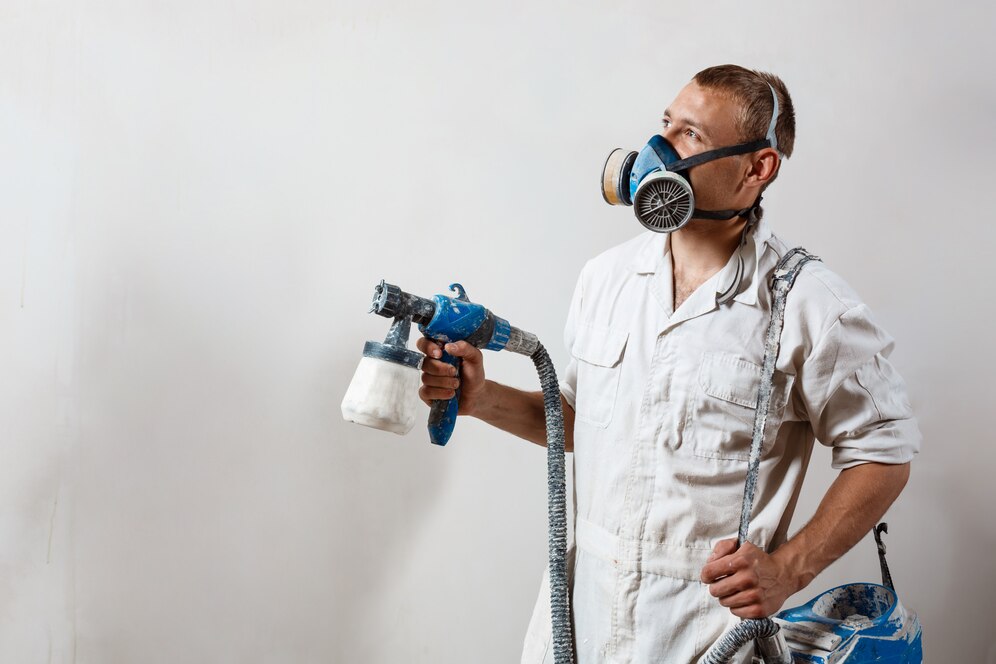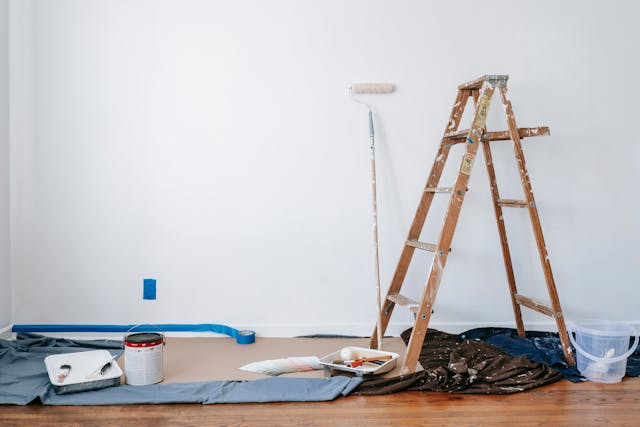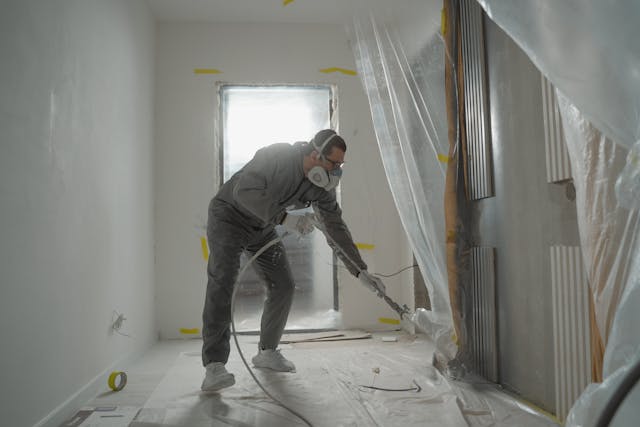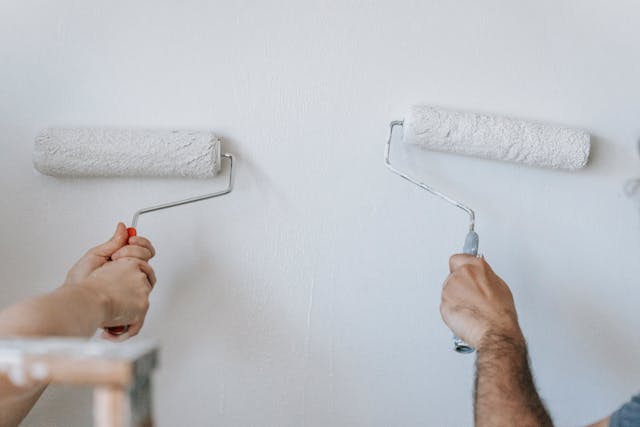
Why Proper Surface Preparation is Key to a Flawless Paint Job
Achieving a flawless paint job isn’t just about choosing the perfect color—it starts long before the first brushstroke. Surface preparation is the foundation of any high-quality paint job, ensuring durability, smooth application, and lasting results. Whether you’re painting a home or business in Avon, CT, proper preparation prevents common issues like peeling, cracking, and uneven finishes.
Here, we’ll explore why surface preparation is so important and the key steps to take to achieve a smooth, long-lasting paint job.
Table of Contents
Key Takeaways
✔ Proper surface preparation, including cleaning, repairing, sanding, and priming, ensures strong paint adhesion and a long-lasting finish.
✔ Skipping preparation steps can lead to peeling, cracking, and an uneven surface, requiring costly touch-ups and repaints.
✔ Sanding smooths imperfections and removes old paint, creating a polished, professional-quality base for painting.
✔ Applying the right primer seals porous surfaces, enhances adhesion, and prevents stains from bleeding through the paint.
✔ Ensuring surfaces are dry and dust-free before painting helps prevent blistering, peeling, and adhesion issues.
✔ Using high-quality tools like scrapers, sanders, and tack cloths improves efficiency and precision during surface preparation.
✔ Investing in thorough preparation saves time, reduces maintenance, and results in a flawless, durable paint job.
7 Essential Steps for Proper Surface Preparation
1. Cleaning the Surface
Proper surface cleaning is crucial for ensuring that paint adheres well and lasts longer. Dirt, dust, and grease can interfere with adhesion, leading to peeling or uneven coverage. Professional painters use various cleaning techniques depending on the surface type.
How to Clean Different Surfaces
- Interior Walls: Use a mild detergent mixed with warm water to wipe down walls, removing dust, stains, and grease buildup.
- Exterior Surfaces: Pressure wash the surface or scrub it with a cleaning solution to remove dirt, mildew, and debris. Allow it to dry completely before proceeding.
- Wood Surfaces: Use specialized wood cleaners or a diluted vinegar solution to clean the surface without damaging the material.
Additional Cleaning Tips
- Target stubborn stains: Apply degreasers for kitchen walls, mildew removers for damp areas, or trisodium phosphate (TSP) for heavy grime buildup.
- Rinse and dry completely: Ensure the surface is fully dry before moving to the next step to prevent moisture-related issues.
- Scrape or sand if needed: If old paint is flaking or peeling, lightly sand or scrape it away to create a smooth foundation for new paint.
2. Repairing Surface Imperfections for a Smooth Finish
Even minor surface flaws can become more noticeable after painting, diminishing the final appearance. Proper repair ensures a seamless, professional-quality finish for siding painting, deck staining, and fence painting.
Thorough Inspection
Before painting, surfaces are carefully examined for cracks, dents, holes, and other irregularities. Identifying these flaws early prevents problems later.
Filling Holes and Cracks
- Drywall – Small holes and cracks are filled with spackle or joint compound. Larger holes may require a patch before applying the compound.
- Wooden Surfaces – Gaps, cracks, or nail holes in wood are repaired using wood filler, ensuring a smooth and even surface before deck staining or fence painting.
Sanding for a Seamless Finish
Once the filler or compound dries completely, sanding is essential to blend the repaired areas with the surrounding surface. Fine-grit sandpaper creates a smooth, paint-ready finish.
Preventing Future Issues
Properly addressing imperfections before painting helps prevent peeling, bubbling, or an uneven texture, ensuring the paint adheres uniformly for long-lasting results.
3. Sanding for a Smooth, Even Base
Sanding is a crucial step in surface preparation, ensuring that paint adheres evenly and results in a professional, long-lasting finish. Whether applied to drywall, wood, or previously painted surfaces, proper sanding techniques help eliminate imperfections and create an ideal base for painting.
Key Benefits of Sanding
- Enhances Paint Adhesion – Removing gloss, rough patches, and uneven textures improves paint grip.
- Smooth Imperfections – Eliminates bumps, old paint drips, and surface irregularities for a flawless finish.
- Prevents Peeling & Chipping – Rough or glossy surfaces can cause paint to peel prematurely, but sanding minimizes this risk.
- Creates a Uniform Texture – Especially important for wood surfaces, where sanding along the grain prevents scratches and inconsistencies.
Best Practices for Effective Sanding
- Selecting the Right Sandpaper
- Fine-grit (120–220) is best for smoothing surfaces before painting.
- Medium-grit (80–120) works well for removing old paint or rough patches.
- Coarse grit (40–80) is suitable for stripping thick layers of paint or heavy imperfections.
- Applying the Proper Technique
- Sand in a circular motion when working with drywall.
- Sand along the grain when working with wood to avoid scratches.
- Apply even pressure to prevent gouging or over-sanding.
- Removing Dust Thoroughly
- A tack cloth, vacuum, or damp rag effectively clears dust particles.
- Ensuring a dust-free surface before priming or painting helps prevent imperfections.
4. Removing Old Paint and Loose Coatings
Properly removing old, peeling, or flaking paint is essential for achieving a smooth, long-lasting finish. If loose coatings are left behind, the new paint may not adhere properly, leading to premature peeling and an uneven appearance.
Assessing the Surface
- Identify areas where paint is peeling, bubbling, or flaking.
- Determine the best removal method based on the type of surface (wood, drywall, metal, or masonry).
Choosing the Right Removal Method
- Scraping – A putty knife or paint scraper is effective for small areas with loose paint.
- Sanding – Sandpaper or a power sander smooths rough edges and removes residual paint.
- Chemical Strippers – Solvent-based or biodegradable removers help dissolve stubborn paint layers, particularly on intricate surfaces.
- Heat Guns – This technique ensures that controlled heat softens old paint, making it easier to scrape away without damaging the underlying surface.
- Pressure Washing (for Exteriors) – A high-pressure washer removes loose paint, dirt, and debris from large exterior surfaces before siding painting or fence painting.
Ensuring a Clean, Paint-Ready Surface
- Remove dust, paint chips, and chemical residue after stripping.
- Smooth any remaining rough patches with a fine-grit sandpaper.
- Repair any surface imperfections before priming and painting.
5. Priming the Surface for Paint Adhesion
Applying a primer is a fundamental step in surface preparation for siding painting, deck staining, and fence painting. Skipping this step can lead to uneven coverage, poor durability, and potential surface imperfections.
Benefits of Priming
- Enhances paint adhesion
- Seals porous surfaces
- Blocks stains and discoloration
- Promotes uniform color
- Increases paint durability

Choosing the Right Primer
Professional painters select primers based on the type of surface and specific project needs:
- Oil-Based Primers – Ideal for wood, metal, and previously painted surfaces, offering excellent adhesion and stain-blocking properties.
- Latex (Water-Based) Primers – Best suited for drywall, masonry, and bare wood, as they dry quickly and are easy to clean.
- Stain-Blocking Primers – Designed for areas with smoke, water stains, or heavy discoloration to prevent stains from bleeding through.
- Bonding Primers – Used on slick or glossy surfaces, such as glass, tiles, or laminate, to improve paint adhesion.
- Masonry Primers – Formulated for concrete, brick, and stucco to prevent alkali burns and moisture-related issues.
6. Ensuring the Surface is Dry and Free of Dust
Moisture and dust can significantly impact the success of a paint job, leading to poor adhesion, blistering, or peeling. Professional painters take the following steps to ensure a properly prepared surface:
Moisture Control
- Allow surfaces to dry completely before applying primer or paint to prevent peeling and blistering.
- Check for dampness, especially in humid environments, basements, or freshly cleaned areas.
- Use dehumidifiers or fans to speed up the drying process in high-humidity conditions.
- Seal leaks or address water damage before painting to prevent future issues.
Dust Removal
- Wipe down the surface with a clean, dry cloth or tack cloth to remove fine dust particles.
- Vacuum or sweep the area before painting to minimize airborne dust.
- Use a microfiber cloth or damp sponge on walls, trim, and furniture to trap lingering dust.
- Inspect the surface under good lighting to ensure no dust or debris remains before painting.
7. Choosing the Right Tools for Surface Preparation
Using the correct tools is essential for efficient and effective surface preparation before siding painting, deck staining, or fence painting
Essential Tools for Surface Preparation
- Scrapers – Used to remove old, peeling paint and stubborn residue for a clean starting surface.
- Sanders and Sandpaper – Smooth rough surfaces, even out imperfections, and improve paint adhesion.
- Electric sanders – Ideal for large areas, speeding up the process and providing consistent results.
- Hand sanding blocks – Best for precision work on trim, edges, and delicate areas.
- Various grit sandpapers – Coarse (for removing heavy buildup), medium (for general smoothing), and fine (for finishing touches).
- Putty Knives and Fillers – Used to apply spackling compound or wood filler to cracks, dents, and holes for a flawless finish.
- Tack Cloths and Microfiber Cloths – Remove fine dust particles after sanding to prevent imperfections in the paint.
- Wire Brushes – Useful for cleaning rough surfaces, such as metal and masonry, to remove rust and loose debris.
- Vacuum or Shop Vac – Helps eliminate dust and debris from sanding, ensuring a cleaner workspace.
- Painters’ Masking Tape – Protects trim, edges, and other areas from accidental paint application.
Additional Considerations
- Choosing high-quality tools enhances precision and reduces effort during surface preparation.
- Using the right applicators (such as fine brushes and rollers) ensures an even application of primer.
- Maintaining tools properly extends their lifespan and contributes to a professional-quality finish.
Top Common Surface Prep Mistakes to Avoid for a Flawless Paint Job
Skipping proper surface preparation can lead to several painting issues, including poor adhesion, premature peeling, and an uneven finish. To achieve a professional and long-lasting result, it is important to avoid these common mistakes:
1. Skipping Cleaning or Sanding Steps
Failing to properly clean and sand surfaces before painting can cause major adhesion issues, leading to premature peeling and an unprofessional finish.
Common Mistakes to Avoid
✔ Skipping cleaning: Painting over dirt, grease, or mold prevents paint from bonding properly, causing flaking and bubbling.
✔ Ignoring old, flaking paint: Leaving loose or peeling paint results in an uneven, patchy appearance.
✔ Failing to sand rough surfaces: Un-sanded surfaces highlight imperfections, making them more visible after painting.
✔ Forgetting to remove dust after sanding: Leftover dust creates a gritty texture in the paint, ruining the smoothness of the finish.
Solution
Always clean surfaces with the appropriate method (detergent, degreaser, or pressure washing), and remove loose paint, and sand where necessary. Wipe down the area with a damp cloth or tack cloth to eliminate dust before priming.
2. Applying Primer on a Wet or Dirty Surface
Moisture trapped under the primer can cause paint to blister, crack, or peel over time. Dust and debris on the surface prevent the primer from bonding properly, leading to uneven coverage. Using the wrong type of primer for the surface material can result in poor adhesion and an inconsistent finish.
Common Mistakes to Avoid
✔ Applying primer on a wet surface: Trapping moisture under the primer can lead to peeling and blistering paint.
✔ Not cleaning the surface properly: Dust, dirt, and grime prevent the primer from adhering properly, creating uneven results.
✔ Using the wrong primer: Choosing the wrong type of primer for the surface can lead to poor adhesion and an inconsistent finish.
✔ Skipping repairs: Failing to repair cracks and holes leaves imperfections visible after the final paint coat.
Solution
Ensure surfaces are clean, dry, and free of moisture before priming. Choose the appropriate primer for the material you’re working with, and repair any cracks or holes before applying primer.
3. Not Allowing Enough Drying Time Between Preparation Stages
Painting over damp surfaces can trap moisture, leading to long-term damage and mold growth. Applying primer or paint too soon after cleaning or patching can weaken adhesion and cause peeling. Failing to let filler or spackle dry completely before sanding can result in an uneven texture.
Common Mistakes to Avoid
✔ Painting over damp surfaces: Trapping moisture between layers can lead to mold growth and damage to the surface.
✔ Not waiting long enough for primer or paint to dry: Applying new layers too soon results in poor adhesion and peeling.
✔ Not allowing filler or spackle to dry completely: Sanding before it’s fully dry creates an uneven texture.
✔ Applying thick coats of paint: Rushing the process with thick layers causes streaking, cracking, and long drying times.
Solution
Allow adequate drying time between each preparation stage. Follow product instructions for drying times, and apply paint in thin layers for the best results. Be patient during the drying process to avoid issues down the line.
Long-Term Benefits of Proper Surface Preparation
Investing time in thorough surface preparation ensures a high-quality paint job that enhances both appearance and durability. Proper preparation reduces the risk of peeling, cracking, and uneven finishes while minimizing the need for future maintenance.
1. Improved Paint Adhesion
A well-prepared surface allows the paint to bond more effectively, preventing premature peeling or flaking. Cleaning, sanding, and priming remove contaminants like dust, grease, and moisture, which can weaken adhesion. This results in a smooth, even application that lasts longer and withstands wear over time.
2. Increased Durability and Longevity
Proper surface preparation strengthens the paint’s resistance to everyday wear and environmental factors. Filling cracks, patching holes, and applying the right primer help protect surfaces from moisture, UV damage, and temperature changes. By addressing these issues before painting, surfaces remain in better condition for longer, reducing the need for frequent repainting.
3. Enhanced Aesthetic Appeal
A smooth and even base ensures a polished, professional-looking finish. Sanding and priming create a consistent texture, preventing imperfections from showing through the final coat. Whether painting walls, siding, or wood surfaces, proper preparation enhances the overall appearance and ensures a flawless result.
4. Cost Savings on Future Maintenance
Skipping surface preparation can lead to premature paint failure, requiring costly touch-ups and repaints. By taking the time to clean, repair, and prime properly, property owners can extend the lifespan of their paint job and reduce long-term maintenance costs. Addressing structural issues before painting also prevents more expensive repairs down the line.
5. Protection Against Environmental Damage
Prepared surfaces are better equipped to withstand exposure to moisture, sunlight, and fluctuating temperatures. Proper sealing and priming prevent water infiltration, reducing the risk of mold, mildew, and structural damage. This added layer of protection ensures the surface remains intact and visually appealing for years to come.
Frequently Asked Questions (FAQs)
Why is surface preparation so important before painting?
Surface preparation ensures that paint adheres properly, leading to a longer-lasting and more professional finish. Skipping preparation can cause issues such as peeling, cracking, and uneven coverage.
How long does proper surface preparation take?
The time required depends on the condition of the surface and the extent of repairs needed. Cleaning, sanding, and priming may take a full day or longer, but the results are well worth the effort.
Can primer be skipped if using high-quality paint?
Primer should never be skipped, as it helps paint adhere better and creates a more even finish. Even high-quality paint performs better when applied over a properly primed surface.
What is the best way to remove old paint before repainting?
Old paint can be removed using a scraper, heat gun, or chemical paint remover, depending on the surface type and the amount of paint that needs to be stripped.
What happens if a surface is not cleaned before painting?
Painting over dirt, grease, or mold prevents proper adhesion and can lead to peeling or bubbling over time. A clean surface is essential for long-lasting results.
Transform Your Space with Avon Professional House Painter
A high-quality, long-lasting paint job starts with proper surface preparation. Cleaning, repairing, sanding, and priming ensure a smooth, even finish that resists peeling and wear over time. Skipping these steps can lead to costly touch-ups and an uneven appearance.
For a stress-free painting experience and professional results in Avon, CT, trust Avon Professional House Painter. Our skilled team takes care of every detail, delivering precision and durability in every project.
Call us today and give your home or business a fresh, flawless look that lasts!


